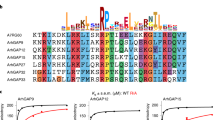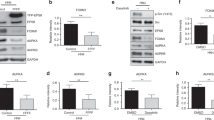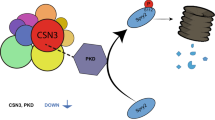Abstract
RACK1 is the founding member of a family of receptors for activated C kinase collectively called RACKs. Upon activation of PKC, RACK1 co-localizes with the Src tyrosine kinase at the plasma membrane and functions as a substrate, binding partner and inhibitor of Src (as measured in vitro), and a growth inhibitor in NIH 3T3 cells. To further analyze the function of RACK1 in Src and PKC signaling, we utilized cell-permeable peptides that modulate the interaction of RACK1 and βIIPKC, thereby affecting βIIPKC translocation and function. We found that the association of βIIPKC and RACK1 is necessary for Src phosphorylation of RACK1. Src activity is required for tyrosine phosphorylation of RACK1, and for RACK1 binding to Src, but not to βIIPKC. Endogenous Src kinase activity, as measured by phosphorylation of Sam68 (a mitotic-specific Src substrate involved in cell cycle regulation and RNA splicing) or p190RhoGAP (a Src substrate and GTPase-activating protein involved in actin reorganization), increases with disruption of the Src-RACK1 complex, and decreases with enhanced complex formation. RACK1 inhibits Src-mediated p190RhoGAP signaling and actin cytoskeleton rearrangement. Thus, RACK1 functions as an endogenous inhibitor of the Src kinase in diverse signaling pathways that regulate distinct cellular functions. Our results demonstrate the potential for using peptide modulators of Src activity as a tool for uncovering the function of Src in cells.
This is a preview of subscription content, access via your institution
Access options
Subscribe to this journal
Receive 50 print issues and online access
$259.00 per year
only $5.18 per issue
Buy this article
- Purchase on Springer Link
- Instant access to full article PDF
Prices may be subject to local taxes which are calculated during checkout




Similar content being viewed by others
References
Aitken A, Baxter H, Dubois T, Clokie S, Mackie S, Mitchell K, Peden A and Zemlickova E . (2002). Biochem. Soc. Trans., 4, 351–360.
Blake RA, Broome MA, Liu X, Wu J, Gishizky M, Sun L and Courtneidge SA . (2000). Mol. Cell. Biol., 20, 9018–9027.
Cartwright CA, Eckhart W, Simon S and Kaplan PL . (1987). Cell, 49, 83–91.
Chang BY, Chiang M and Cartwright CA . (2001). J. Biol. Chem., 276, 20346–20356.
Chang BY, Conroy KB, Machleder EM and Cartwright CA . (1998). Mol. Cell. Biol., 18, 3245–3256.
Chang BY, Harte RA and Cartwright CA . (2002). Oncogene, 21, 7619–7629.
Chang J, Gill S, Settleman J and Parsons SJ . (1995). J. Cell Biol., 130, 355–368.
Donovan S, Shannon KM and Bollag G . (2002). Biochim. Biohys. Acta, 1602, 23–45.
Dorn GW and Mochly-Rosen D . (2002). Annu. Rev. Physiol., 64, 407–429.
Fincham VJ, Chudleigh A and Frame MC . (1999) 112, 947–956.
Hanke JH, Gardner JP, Dow RL, Changelian PS, Brissette WH, Weringer EJ, Pollock BA and Connelly PA . (1996). J. Biol. Chem., 271, 695–701.
Hay JC, Hirling H and Scheller RH . (1996). J. Biol. Chem., 271, 5671–5679.
Kmiecik TE and Shalloway D . (1987). Cell, 49, 65–73.
Lipsich LA, Lewis AJ and Brugge JS . (1983). J. Virol., 48, 352–360.
Lukong KE and Richard S . (2003). Biochim. Biophys. Acta, 1653, 73–86.
Mochly-Rosen D . (1995). Science, 268, 247–251.
Newton AC . (1995). J. Biol. Chem., 270, 28495–28498.
Piwnica-Worms H, Saunders KB, Roberts TM, Smith AE and Cheng SH . (1987). Cell, 49, 75–82.
Reynolds AB, Vila J, Lansing TJ, Potts WM, Weber MJ and Parsons JT . (1987). EMBO J., 6, 2359–2364.
Ron D, Chen CH, Caldwell J, Jamineson L, Orr E and Mochly-Rosen D . (1994). Proc. Natl. Acad. Sci. USA, 91, 839–843.
Ron D, Luo J and Mochly-Rosen D . (1995). J. Biol. Chem., 270, 24180–24187.
Ron D and Mochly-Rosen D . (1995). Proc. Natl. Acad. Sci. USA, 92, 492–496.
Roof RW, Dukes BD, Chang JH and Parsons SJ . (2000) 472, 117–121.
Roof RW, Haskell MD, Bernard DD, Sherman N, Kinter M and Parsons SJ . (1998). Mol. Cell. Biol., 18, 7052–7063.
Schechtman D and Mochly-Rosen D . (2001). Oncogene, 20, 6339–6347.
Souroujon MC and Mochly-Rosen D . (1998). Nat. Biotechnol., 16, 919–924.
Stebbins EG and Mochly-Rosen D . (2001). J. Biol. Chem., 276, 29644–29650.
Thomas SM and Brugge JA . (1997). Annu. Rev. Cell Dev. Biol., 13, 513–609.
Acknowledgements
We thank Toufan Parman for critical review of the manuscript. This work was supported by grants from the National Institutes of Health to CAC (R01 DK43743) and DM-R (R01 HL52141). LDM was supported, in part, by NIH Digestive Disease Center grant DK65339.
Author information
Authors and Affiliations
Corresponding author
Rights and permissions
About this article
Cite this article
Miller, L., Lee, K., Mochly-Rosen, D. et al. RACK1 regulates Src-mediated Sam68 and p190RhoGAP signaling. Oncogene 23, 5682–5686 (2004). https://doi.org/10.1038/sj.onc.1207735
Received:
Revised:
Accepted:
Published:
Issue Date:
DOI: https://doi.org/10.1038/sj.onc.1207735



